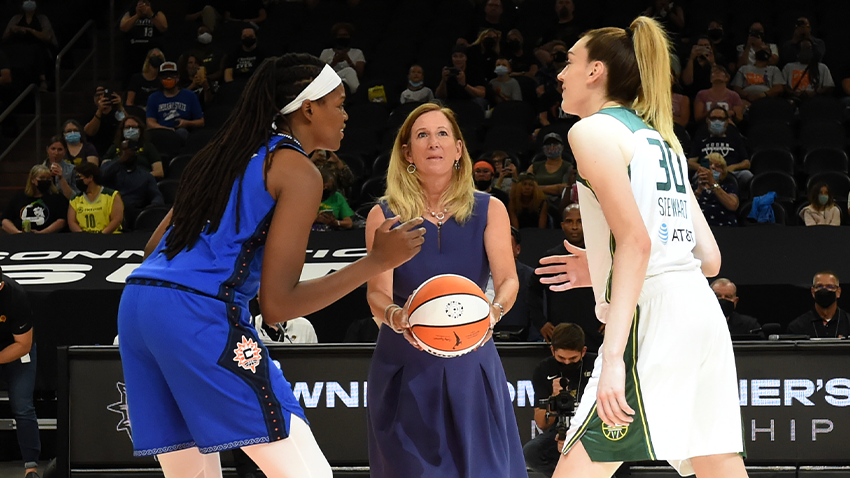Inside The W with Michelle Smith: Lisa Borders Q&A Part I

Lisa Borders rode a wave of history to the helm of the WNBA.
The WNBA President assumed the position at the start of the league’s landmark 20th season — a year marked by change, accomplishment and unquestioned success.
In a wide-ranging conversation with WNBA.com, the President talked about the remarkable season that was, as well as the path that lies ahead for the longest-running women’s professional sports league.
In Part I of this interview, we look back with Borders on her first season as WNBA President and its mark on the history of women’s sports.
Q&A PART II | INSIDE THE W ARCHIVE
As you assumed your role as President, did you have a sense of the enthusiasm that built in advance of the 2016 season?
Absolutely. We started with the “Watch Me Work” campaign during the winter, and it was the earliest time frame for a marketing campaign we’d done in league history. That generated some early interest and enthusiasm for the season to come. We started the campaign with a Cleveland Cavaliers game on ABC. We rolled into the NBA All-Star Game and the activities on All-Star Weekend. We pushed the campaign out in the traditional places, ESPN and NBA broadcasts, but we also did some more non-traditional things. We really made a big push on social media. Our video views were up. We cemented our social media presence as something that consumers and fans could really get their arms around.
People really embraced the 20th season, and that enthusiasm rolled from the end of the NCAA season right into our draft. We had an extraordinary draft class. The first three players in the draft all came from Connecticut and that was very unique for us. From the season tip-off to the ring ceremony in Minnesota, we could feel the excitement of the fans.
What were some of the other indications that 2016 would be a special season for the league?
It’s not just my opinion that we were enthusiastically received. We have empirical evidence that people were on board in a major way. Viewership was up 18 percent. Merchandise sales were up 30 percent. Breanna Stewart, our No. 1 draft pick, had the top-selling jersey this season. The Seattle Storm led the league in merchandise sales overall. Video views on WNBA.com were up 50 percent. Our social media following went from nine to 12 million people. I thought fans, sponsors, everybody was all in.
Is it possible to overstate the significance of the league’s 20th anniversary?
20 years. That’s two decades. We are the longest running women’s professional league ever. We have planted a flag in the ground in terms of endurance. It was more than a milestone for us. Not to mention that we had our players leading a national team that went for its sixth consecutive gold medal.
How did the retirement of some of the league’s core players add to the historical context of the 2016 season?
We saw Tamika Catchings and Swin Cash, Penny Taylor and Jayne Appel-Marinelli retire. They were veterans, big trees in the forest for us. They were impactful players. Tamika played 15 years, she was president of the Players Association for nearly the entire time, she worked off the court, in the community, as well as leading her basketball sisters. Swin played 15 years, she was an All-Star, she had her own foundation and helped lead the social justice conversation for the league. These two and many others were role models, on and off the court. That impact is felt by the league. Marian Wright Edelman said, “You cannot be what you cannot see,” and what young boys and girls saw in these women were role models who were able to perform on the court and give back to the next generation.
How did the competitive postseason, particularly the Finals series, add to the legacy of the league?
It added to the innovation of our game. The best two teams played against one another, and that added a tremendous amount of excitement. I challenge anyone to show me a more exciting arena of play during those five games. We gave our fans an extraordinary experience and our players delivered. The whole playoff format produced a sense of urgency. Teams had to bring their A-plus games or lose and be eliminated.
What impact did the players’ stance on social justice issues have on the season?
We live in a complicated time and environment. I would say about our players that their EQ is equal to their IQ. They are not just compassionate and sympathetic, they are empathetic. The things that are happening in the world aren’t just happening to someone else in their communities, but in their own families. They have taken the opportunity to be constructive in their communities and make them stronger. They have talked with police officers and grassroots organizations and young people. You can disagree with them, but appreciate that they feel the way they do. Those two things are not mutually exclusive. Our players are expanding their pool of knowledge. They are using the game as a platform, and I know they will be maintaining and sustaining those efforts going forward.
Longtime WNBA reporter Michelle Smith wrote a weekly column on WNBA.com throughout the 2016 season and will continue to contribute throughout the offseason.
The views on this page do not necessarily reflect the views of the WNBA or its clubs.
,xPosition=.5,yPosition=.5)
,xPosition=.5,yPosition=.5)
,xPosition=.5,yPosition=.5)
,xPosition=.5,yPosition=.5)